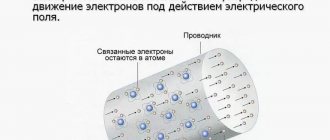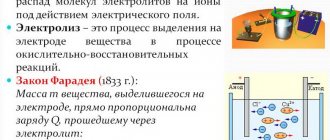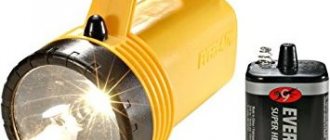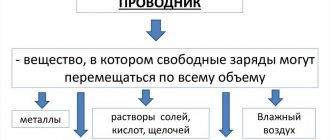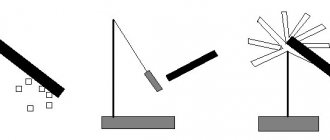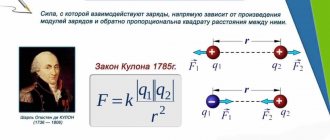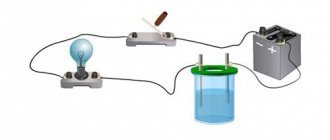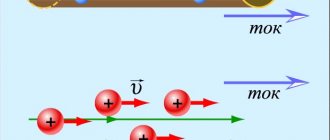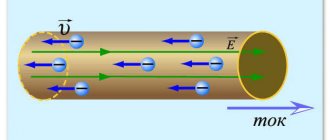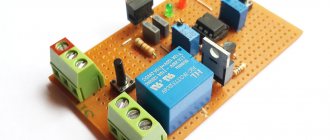Types of vacuum
How does electric current behave in a vacuum? Like any current, a current in a vacuum appears in the presence of a source with free charged particles.
What particles create an electric current in a vacuum? To create a vacuum in any closed vessel, it is necessary to pump out the gas from it. This is most often done using a vacuum pump. This is a device that is necessary to pump out gas or steam to the pressure required for the experiment.
There are four types of vacuum: low vacuum, medium vacuum, high vacuum and ultra-high vacuum.
Rice. 1. Vacuum characteristics
§ 112. Electric current in a vacuum. Cathode-ray tube
What are the conditions for the existence of electric current?
Before the discovery of the unique properties of semiconductors, only vacuum tubes were used in radio engineering.
By pumping gas from a vessel (tube), you can obtain a gas with a very low concentration of molecules.
| Remember The state of a gas in which molecules manage to fly from one wall of a vessel to another without ever experiencing collisions with each other is called vacuum . |
If two electrodes are placed in a vessel with a vacuum and connected to a current source, then no current will flow between the electrodes, since there are no charge carriers in the vacuum. Therefore, to create a current, there must be a source of charged particles in the tube.
Thermionic emission. Most often, the effect of such a source of charged particles is based on the property of bodies heated to a high temperature to emit electrons.
| Remember The phenomenon of electron emission from heated metals is called thermionic emission . |
This phenomenon can be considered as the evaporation of electrons from the surface of the metal. For many solids, thermionic emission begins at temperatures at which the evaporation of the substance itself does not yet occur. Such substances are used to make cathodes.
One-way conduction. Diode. The phenomenon of thermionic emission leads to the fact that a heated metal electrode, unlike a cold one, continuously emits electrons. Electrons form an electron cloud
. The electrode becomes positively charged, and under the influence of the electric field of the charged cloud, electrons from the cloud are partially returned to the electrode.
In the equilibrium state, the number of electrons leaving the electrode per second is equal to the number of electrons returning to the electrode during this time. The higher the temperature of the metal, the higher the density of the electron cloud.
When the electrodes are connected to a current source, an electric field arises between them. If the positive pole of the current source is connected to a cold electrode (anode), and the negative pole to a heated one (cathode), then the electric field strength vector is directed towards the heated electrode. Under the influence of this field, electrons partially leave the electron cloud and move towards the cold electrode. The electrical circuit is closed and an electric current is established in it. When the source is turned on in opposite polarity, the field strength is directed from the heated electrode to the cold one. The electric field pushes the cloud's electrons back toward the heated electrode. The circuit appears to be open.
| One-way conductivity was previously widely used in electronic devices with two electrodes - vacuum diodes, which, like semiconductor diodes, served to rectify electric current. However, at present, vacuum diodes are practically not used. |
If a hole is made in the anode of an electron tube, then some of the electrons accelerated by the electric field will fly into this hole, forming an electron beam behind the anode. The number of electrons in the beam can be controlled by placing an additional electrode between the cathode and anode and changing its potential.
Properties of electron beams and their applications. Streams of electrons emitted by the cathode moving in a vacuum are sometimes called cathode rays
Let us list the properties of electron beams (cathode rays).
- 1) Electrons in a beam move in straight lines.
2) An electron beam hitting the target transfers part of its kinetic energy to it, which causes it to heat up. In modern technology, this property is used for electronic melting in vacuum of ultrapure metals.
3) When fast electrons hitting a substance are decelerated, X-rays are generated. This phenomenon is used in X-ray tubes.
4) Some substances (glass, zinc and cadmium sulfides) bombarded by electrons glow. Currently, materials of this type (luminophores) are those in which up to 25% of the energy of the electron beam is converted into light energy.
5) Electron beams are deflected by an electric field. For example, passing between the plates of a capacitor, electrons are deflected from a negatively charged plate to a positively charged one (Fig. 16.20).
6) The electron beam is also deflected in a magnetic field. Flying over the north pole of a magnet, electrons are deflected to the left, and flying over the south pole, they are deflected to the right. The deviation of electron flows coming from the Sun in the Earth's magnetic field leads to the fact that the glow of gases in the upper layers of the atmosphere (aurora) is observed only at the poles.
7) Electron beams have ionizing ability.
Electron beams can pass through very thin metal plates with a thickness of 0.003-0.03 mm.
Cathode-ray tube. The ability to control an electron beam using an electric or magnetic field and the glow of a phosphor-coated screen under the action of the beam is used in a cathode ray tube.
The cathode ray tube was the main element of the first televisions and the oscilloscope, a device for studying rapidly changing processes in electrical circuits (Fig. 16.21).
The structure of a cathode ray tube is shown in Figure 16.22. This tube is a vacuum cylinder, one of the walls of which serves as a screen. At the narrow end of the tube there is a source of fast electrons - an electron gun.
(Fig. 16.23). It consists of a cathode, a control electrode and an anode (usually several anodes are located one behind the other). Electrons are emitted by a heated oxide layer from the end of a cylindrical cathode C, surrounded by a heat shield H. They then pass through a hole in the cylindrical control electrode B (it regulates the number of electrons in the beam). Each anode (A1 and A2) consists of disks with small holes. These discs are inserted into metal cylinders. A potential difference of hundreds and even thousands of volts is created between the first anode and the cathode. A strong electric field accelerates the electrons and they acquire greater speed. The shape, location and potentials of the anodes are chosen so that, along with the acceleration of electrons, the electron beam is also focused, i.e., the cross-sectional area of the beam on the screen is reduced to almost point sizes.
On its way to the screen, the beam sequentially passes between two pairs of control plates, similar to the plates of a parallel-plate capacitor (see Fig. 16.22). If there is no electric field between the plates, then the beam is not deflected and the luminous point is located in the center of the screen. When a potential difference is imparted to vertically located plates, the beam is displaced in the horizontal direction, and when a potential difference is communicated to horizontal plates, it is displaced in the vertical direction.
The simultaneous use of two pairs of plates allows you to move the luminous point across the screen in any direction. Since the mass of electrons is very small, they react almost instantly, i.e. in a very short time, to changes in the potential difference of the control plates.
Electric current in a vacuum
Current in a vacuum cannot exist independently, since vacuum is a dielectric. In this case, a current can be created using thermionic emission. Thermionic emission is a phenomenon in which electrons escape from metals when heated. Such electrons are called thermionic electrons, and the entire body is an emitter.
This phenomenon was first noticed by the American scientist Thomas Edison in 1879.
Rice. 2. Thermionic emission
Emission is divided into:
- secondary electron (knocking out by fast electrons);
- thermionic (evaporation of electrons from a hot cathode);
- photoelectronic (electrons are knocked out by light);
- electronic (knocking out with a strong field).
Electrons will be able to fly out of the metal if they have sufficient kinetic energy. It must be greater than the electron work function for a given metal. Electrons escaping from the cathode form an electron cloud. Half of them return to their original position. In the equilibrium state, the number of electrons emitted is equal to the number of electrons returned. The density of the electron cloud depends directly on the temperature (i.e., as the temperature rises, the density of the cloud becomes greater).
When the electrodes are connected to a source, an electric field arises between them. If the positive pole of the current source is connected to the anode (cold electrode), and the negative pole to the cathode (heated electrode), then the electric field strength will be directed towards the heated electrode.
How can electric current appear in a vacuum?
In order to create a full electric current in a vacuum, it is necessary to use such a physical phenomenon as thermionic emission. It is based on the property of a particular substance to emit free electrons when heated. Such electrons leaving a heated body are called thermionic electrons, and the entire body is called an emitter.
Thermionic emission underlies the operation of vacuum devices, better known as vacuum tubes. The simplest design contains two electrodes. One of them is the cathode, which is a spiral, the material of which is molybdenum or tungsten. It is he who is heated by electric current. The second electrode is called the anode. It is in a cold state, performing the task of collecting thermionic electrons. As a rule, the anode is made in the shape of a cylinder, and a heated cathode is placed inside it.
Vacuum diode
One of the typical devices using the conductivity of airless space is a vacuum two-electrode electron tube. If a reverse voltage is applied to its positive terminal, then all the electrons emitted by the cathode are returned. With forward bias, charge carriers rush towards the anode. In other words, the alternating signal is rectified. The device works like a diode.
You can study the appearance of electric current in a vacuum and gases using a radio element consisting of the following parts:
- sealed flask;
- metal electrode (anode);
- tungsten spiral (cathode);
- rheostat.
The tungsten filament is in a sealed flask and connected through a rheostat to a generator to regulate the current. The electrode is connected to a microammeter. From it, the circuit, passing through the ballast resistor, closes at the cathode.
The rheostat can be used to regulate the temperature of the cathode. Variable resistance sets the potential difference between the positive and negative terminals. The current-voltage characteristic, that is, the dependence of the anode current on voltage, will be formed as follows. Let's say there is no voltage. Then the electrons emitted from the cathode will be attracted back. No current flows in the anode circuit. If a negative signal is applied to the pin, the electrons will be repelled. No current flows again.
When a positive voltage is applied to the anode, an electric field is created. It creates a force directed towards the anode. The speed of flight of electrons is different, since some of them are repelled by previously emitted particles. The greater the field strength, the stronger the current will begin to flow. But the change will not occur linearly. For example, if the voltage is doubled, the number of electrons emitted from the cathode will increase by more times than this number. The greater the potential difference, the less the space charge of the electrons.
On the graph, this dependence will represent a semi-cubic parabola. It can be described by an approximate formula: I = U 3/2. If you continue to increase the voltage, the tension becomes much greater than the field created by the spatial cloud. All electrons will begin to reach the anode. The current strength will no longer depend on the voltage. This is represented by a straight line on the current-voltage characteristic, and the effect is called saturation current.
Electric current in a vacuum briefly, what particles are created
Emptiness is how the word vacuum is translated from Latin. Vacuum is usually called a space in which there is gas, the pressure of which is hundreds, and maybe thousands of times lower than atmospheric pressure. On our planet, a vacuum is created artificially, since such a state is impossible under natural conditions.
